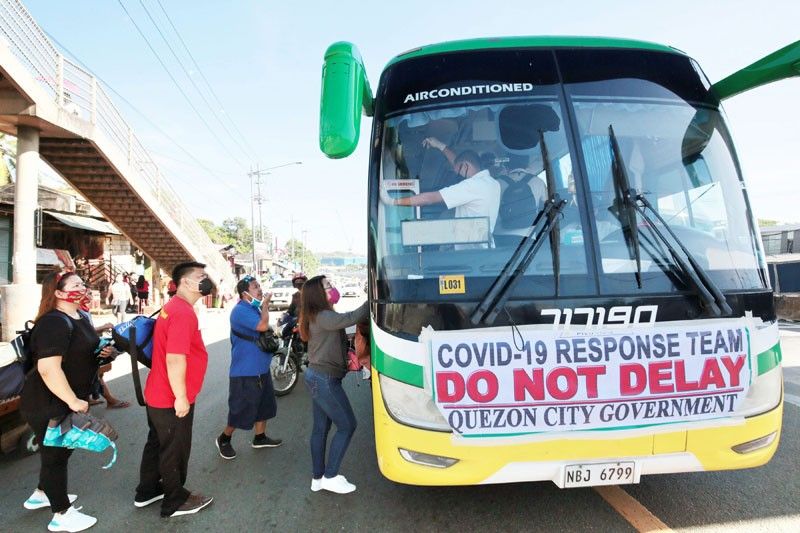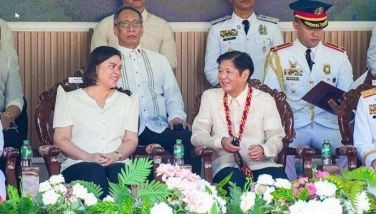Day 2: More buses ease transport woes

MANILA, Philippines — Transport authorities deployed more buses yesterday to prevent a repeat of the previous day’s scenario, wherein thousands of commuters returning to work on the first day of the general community quarantine (GCQ) were stranded along Metro Manila’s major roads.
Transportation Assistant Secretary Albert Suansing told “The Chiefs” on One News Monday night that hundreds of buses would be deployed to ferry passengers along major roads in Metro Manila.
Metropolitan Manila Development Authority (MMDA) spokesperson Celine Pialago said 16 buses served commuters along Commonwealth Avenue yesterday and another 14 were deployed to provide free rides.
Aside from buses, the local government of Quezon City and the military deployed trucks and utility vehicles to accommodate passengers.
Defense Secretary Delfin Lorenzana said the Armed Forces of the Philippines deployed 48 trucks and buses to the MMDA, which the agency can use to augment the transport needs of commuters in the National Capital Region.
MMDA general manager Jojo Garcia said more bus routes will be identified in the coming days to address the needs of the commuting public.
“We cannot just provide free rides every day. We need to address the needs of the commuters. Special permits will be given to allow for more temporary bus routes,” Garcia said.
Public utility buses and modern jeepneys will be allowed on the road on reduced passenger capacity during the second phase of GCQ starting on June 22, Garcia said.
Shuttle for employees
Transportation Secretary Arthur Tugade urged employers to provide shuttle service for their employees.
“The Duterte administration is appealing to the employers to please, do not order all your employees to return to work, only 50 percent should report to work based on what we agreed upon,” Tugade said in Filipino during a press briefing in Malacañang yesterday.
“We are telling the employers to find ways and set the days when workers can go to work, implement flexitime or the work-from-home scheme or a four-day workweek,” he said.
Most commuters had to walk to and from work on Monday, the first day of the GCQ.
Following the chaos brought about by the return of workers in Metro Manila and other areas, Tugade said the government also sees the need to augment the bus services and pick-up points, particularly along problem areas such as EDSA and the routes to the Metro and Light Rail transits.
“It does not mean that we can all go out and go to work under GCQ,” he said.
Tugade said the Department of Transportation (DOTr) is planning to put up more pick-up stations to accommodate more passengers, especially along EDSA.
For the deployment of city buses, the government has started to map out strategy to open up routes outside Metro Manila.
Tugade ordered Land Transportation Franchise and Regulatory Board (LTFRB) chairman Martin Delgra to draw up bus routes from Angat in Bulacan to Quezon Avenue in Quezon City, and Dasmariñas in Cavite to the Parañaque Integrated Terminal Exchange (PITX).
Delgra said they are checking more routes that need to be opened to prevent workers from getting stranded.
The LTFRB earlier trimmed down bus routes by more than half, from 96 to 31, to “rationalize routes” under the GCQ.
Stops where buses can pick up and drop off passengers have been changed, which is one of the reasons why thousands of commuters were stranded on Monday.
Starting yesterday, two more routes were activated to serve commuters north and south of Metro Manila.
Tugade said the DOTr is adjusting to the needs of the commuting public on a day-to-day basis.
While many were inconvenienced, Tugade denied that the government totally disregarded the welfare of the working populace when it failed to provide transportation to those returning to work.
He said the coronavirus disease 2019 (COVID-19) crisis prompted a change in the transportation sector due to the need to impose minimum health standards, affecting the number of passengers that can be accommodated in public buses and trains.
Labor groups blamed the DOTr and other agencies for allegedly failing to provide necessary transportation for workers on Monday.
Thadeus Ifurung, spokesman for Defend Job Philippines, said commuters would not have suffered such difficulties had the government been “scientific, objective and effective enough in enforcing rules.”
Labor coalition Nagkaisa said the government shouLd have allowed public utility vehicles (PUV) to augment the limited public transportation.
It said the government should pay PUV operators and drivers to run predetermined routes to ferry the workers.
Ifurung said the government must fix its own rules and focus on how to craft policies that would provide sufficient mode of transport for the people as well as ensure their health and safety at all times.
The people, he said, should not be blamed and punished for their failure to observe physical distancing and health standards on the first day of GCQ.
The groups issued the statement after Garcia said over “The Chiefs” on Monday night that the commuters seemed to have forgotten social distancing during the first day of GCQ.
“How do our stranded workers and commuters practice social distancing if the government prohibits public mass transportation to operate?” Ifurung asked.
He said commuters had to rely on a few free rides that the government provided, which resulted in flouting the social distancing rule.
In limiting public commute, Garcia said transport authorities only wanted to protect people’s health.
“Our priority is the safety and health of the people. It is only our second priority to allow people to travel from point A to point B,” he said.
Garcia’s statement did not sit well with netizens, who reminded him that it is government’s job to help commuters during the pandemic.
“That happened because you neglected the people. You allowed people to commute, and then you get mad at them for finding ways to go to work?” tweeted Elvin Evangelista.
“Why not try to go to work without using a private car? Do commuters have a choice? Why blame them when they had been unemployed and unpaid for two months?” added Markee Alcabedos also on Twitter.
Ifurung said the government should stop making it appear that the riding public caused the disorder and confusion.
He said the lack of public transport makes workers and commuters more vulnerable to COVID-19.
Only the buses under the bus augmentation program, shuttle buses and trains were allowed to operate at reduced capacity under the first phase of GCQ.
Senators blamed Tugade for the inconvenience that the riding public had to endure going to and from work.
Despite having more than two months to prepare, lawmakers said the failure of the DOTr was evident when thousands of workers could not get safe transportation on Monday.
Sen. Nancy Binay challenged DOTr executives to commute to work and experience for themselves the supposed road transport guidelines they have put in place.
She said the DOTr had no clear plans for the commuters and the lack of buses or other forms of public transportation was severe.
With many jeepney routes left unserved, Binay said the government abandoned a critical social and economic sector, which has a big impact on the economy and people.
Sen. Joel Villanueva, chairman of the Senate committee on labor and employment, said the large volume of workers stranded on the streets of Metro Manila showed “the lifeblood of the economy got the short end of the stick once again.”
For industries to restart toward economic recovery, people’s labor is essential to attain these, Villanueva said.
Sen. Grace Poe, chair of the public services committee, urged the government to immediately fill the need for public transport without compromising safety.
Poe said it was clear that the mass transport did not meet the surge of people “who have come out of quarantine to start working again to feed their families.”
She urged companies and businesses to maximize the work-from-home scheme to lessen the number of people on the street.
Sen. Risa Hontiveros urged the government to adopt a service contracting program with the transportation sector to prevent commuter crisis.
“The lack of transport options is not just an emerging crisis for commuters, it is also a serious health hazard,” Hontiveros said.
National Task Force against Coronavirus Disease 2019 response chief implementer Carlito Galvez Jr. said the task force is coordinating with the DOTr and the MMDA to address the problems faced by commuters.
“What we did is we reinforced our reserved buses at the PITX,” Galvez said.
He said he had met with Garcia on what was best to do at the moment.
“Our Operation Center is now connected to the MMDA and the National Capital Region Police Office and the National Incident Command. We are monitoring the situation and it has normalized,” Galvez said. Christina Mendez, Mayen Jaymalin, Paolo Romero, Marc Jayson Cayabyab, Neil Jayson Servallos, Jose Rodel Clapano, Cecille Suerte Felipe, Jose Rodel Clapano
- Latest
- Trending





























